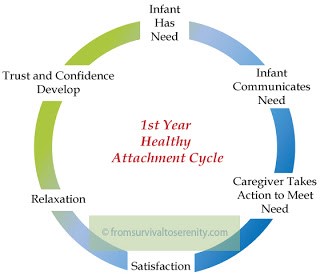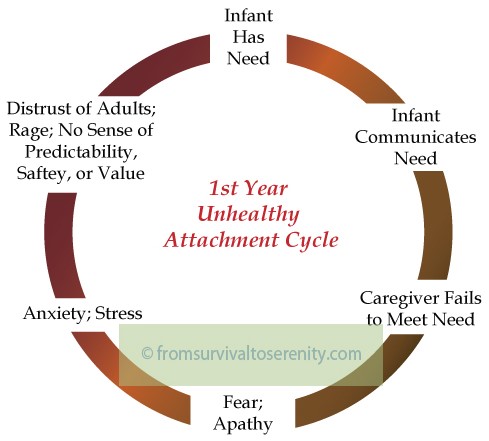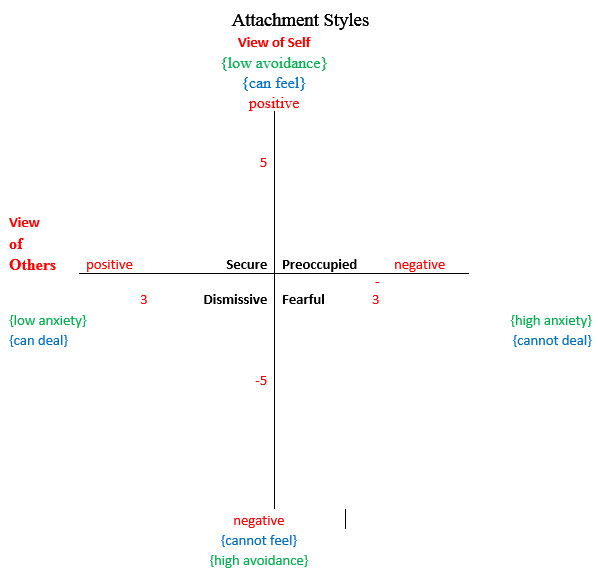Attachment Types
Attachment is the emotional bond between a child and a caregiver. This bond is necessary for the emotional, social and behavioral growth of a child. It is a reciprocal, enduring, emotional and physical connection between a child and a caregiver. This bond begins to develop as soon as the child and the caretaker are introduced. The primary role of the caretaker is to be a protector, a provider and a guide.
The graphic illustrates a healthy attachment cycle. This cycle, repeated over and over again during the first year of life, builds and strengthens the bond between child and caregiver. The child learns that needs can be met, and the caregiver learns she is capable of meeting the child’s needs. A child whose needs are met feels safe and explores the environment, which encourages healthy development. When the caregiver responds consistently to a child’s needs, the child begins to feel confidence in herself and her ability to express herself. The child’s experience of herself is positive, setting the stage for a healthy sense of self-esteem. The child’s perception of how to relate to others and how others relate to her is positive. This positive interaction is the foundation for all future experiences, relationships and interactions.
In cases of early childhood trauma, this attachment is interrupted. The second graph illustrates what happens in an unhealthy bonding cycle. Any number of events and circumstances can disrupt a healthy attachment style. These incidents include prenatal drug and alcohol exposure, physical and sexual abuse, witnessing domestic violence, caregiver mental health issues, neglect, separation from parents through foster care placements and moves. An unhealthy attachment lacks reciprocal interactions; there is either the absence of a counter action to a child’s action or an unpredictable counter action.
At the time when healthy or unhealthy attachments are formed, the right hemisphere of the brain is the dominant portion. It is “online” at birth. Several very important control centers are located in the right hemisphere, including those for emotion, memory, stress regulation, the “meaning of life,” understanding of others and most of the major organs.
Healthy attachment sets the stage for collaboration, cooperation, attention span, empathy. A healthy attachment also helps a child learn about feelings and helps with the understanding of feelings in others. Alternatively, the lack of a healthy attachment blunts or stifles those characteristics.
The attachment cycle and interactions during infancy lead to four basic types of childhood attachment: secure, preoccupied, dismissive and fearful. The Attachment Styles graph illustrates the continuum of attachment styles. Attachment styles can fall anywhere on the continuum from secure to fearful depending on the degree of positivity or negativity a child feels.
A child whose view of himself is generally positive and whose view of others is generally positive has a secure attachment. This child can generally be categorized as having low anxiety levels and is engaging with people and situations. This child is generally able to cope with life’s stresses and has a full range of emotions.
When a child has a generally positive self-esteem combined with a generally negative view of others, the child has a preoccupied attachment style. This child can generally be categorized as showing some avoidance characteristics and some emotional blunting. This child is likely to be anxious and may have poor coping skills. Such a child is just waiting for events in his world to prove his belief that the world is not a very safe place.
The child with a lower self-esteem but a generally positive view of others will have a dismissive attachment. This is a child who does not have a wide range of emotions and feelings and is likely to be avoidant, both of his own and others’ feelings. This child generally has a lower anxiety level and moderate coping skills. This is the child who watches and observes, but does not feel worthy of being included. As a result, he masks his feelings with thoughts and expressions along the lines of “this is dumb.”
When a child has a poor self-esteem and a negative view of others, the child has a fearful attachment style. This child has very blunted emotions and a high level of avoidance, especially avoidance of emotions and relationships. The child has a very high level of anxiety and very poor coping skills and perceives himself as bad, stupid, worthless, unworthy or unwanted. Others are viewed as violent, cruel, rejecting and unpredictable.
There are many symptoms of traumatic or fearful attachment.
- Compulsive need to control others and the environment
- Lying
- Aggressive or defiant reaction to discipline
- Too little or too much physical attachment
- Poor eating, sleeping and voiding habits
- Poor communication – avoidance or silence
- Lack of empathy
- “All or nothing” thinking
- Pervasive shame
- Denying thoughts and feelings
- Rejecting others
Anyone who works with children with traumatic histories must understand the impact of an unhealthy attachment. The quality of the primary relationship does not always indicate the strength of that relationship. When that understanding is fostered, those individuals whose children have trauma histories can be helped to overcome the impact of the past.



